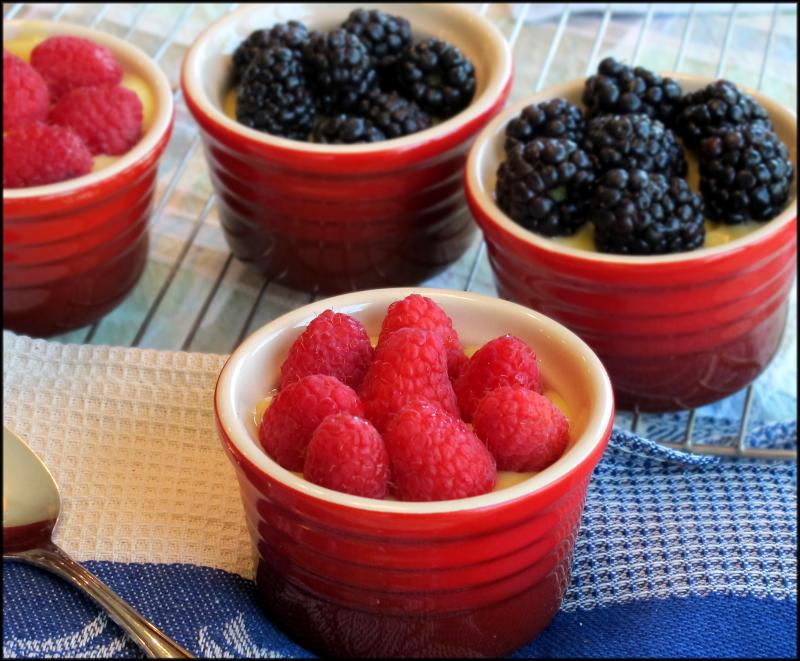Custard is an ideal light dessert
On a recent visit to the grocery, I succumbed to the mountain of clamshell boxes filled with juicy berries. The sign advertising “buy one get one free” made them all the more alluring. And, unlike the desiccated fruit more often offered, these berries were unblemished and perfectly ripe.
After a few bowls of raspberry-garnished morning cereal and a spinach salad tossed with blackberries, there were only a few berries left. I decided a light dessert might be the best destination for these beauties and began searching for a fruit custard recipe.
Looking through my cookbooks, I found not only lemon custard (featured as a filling for pastry or to hold up a layer of meringue on a pie) but also lemon curd. What’s the difference? They differ in both essential ingredients and preparation.
Custards are a cooked mixture of milk and egg, typically assembled stovetop or baked in a water bath. They range in texture from a pourable sauce to a pudding-style consistency, depending on the amount and type of thickener, which can be flour, cornstarch, gelatin or a combination.
Custards are often sweetened and flavored with vanilla, citrus juice or chocolate for desserts. Savory preparations such as quiche feature vegetables, herbs and cheese or meat. Knowing this, you would correctly expect lemon custard to have a smooth texture and a delicate lemon flavor.
Lemon curd, on the other hand, offers an intense lemon flavor and a silky consistency. Simmered stovetop in a double boiler, ingredients include fresh lemon juice, lemon zest, egg yolks, sugar and butter. Instead of added thickeners, lemon curd relies on the natural pectin in the grated rind to thicken the mixture.
Both preparations are straightforward and simple to make, but require time and attention for success. With custard, the eggs are tempered to keep them from hardening when they’re added at the end of the cooking time. To do this, a bit of the heated mixture is whisked into the beaten eggs and then returned to the pot for the final minute or so of cooking.
Lemon curd uses only egg yolks, which are whisked together with the other ingredients before the mixture is heated. The color is a lovely yellow shade, compared to the lighter hues of lemon custard. While both can perform the role of filling for a pie or pastry, lemon curd’s richer flavor and thicker texture make it a star when spread on toast or a warm scone.
As I sorted through various recipes, I realized the filling for a lemon meringue pie is actually a cross between a custard and a curd. I also noticed I was missing a key ingredient: lemons (we only had one). However, we did have eight oranges in the refrigerator, which could readily substitute for lemon in a custard.
To avoid the additional calories from a graham cracker or pastry crust, I simply poured the custard into ramekins before topping with fresh berries. As you can see from the photo, the mixture was thick enough right out of the pan to keep the berries from sinking. What you can’t see from the photo is that Jack didn’t wait for them to be chilled before sampling one.
I’ve included my recipe for the orange custard in the picture, a decadent lemon curd, and a traditional lemon meringue pie - all delicious served with fresh berries.
Orange Custard
1/3 C sugar
1/3 C flour
1/4 t salt
1 C whole milk
1/2 C orange juice
1 egg
Sift sugar, flour and salt into a saucepan. Whisk in milk, stirring until smooth. Whisk in orange juice and place pan over medium heat. Cook, whisking constantly until mixture boils. Cook for 1 minute and remove from heat. In a small bowl, beat egg until frothy. Whisk 1/2 C hot mixture into egg and return mixture to the pan. Cook just below a simmer, whisking constantly, until thickened. Transfer custard into 4 ramekins and top with fresh berries. Chill before serving.
Lemon Curd
5 egg yolks
3/4 C sugar
4 lemons
6 T salted butter, chopped
Fill a saucepan with water to 1/3 from the top. Place over high heat and bring to a boil. Reduce heat to keep the water at a gentle simmer. Zest and juice the lemons; set aside. Combine the egg yolks and sugar in a medium bowl. Using a hand mixer, beat until smooth. Add lemon zest and juice; mix to combine. Set the bowl on the rim of the saucepan and cook, whisking constantly. The mixture is thickened enough when it coats the back of a wooden spoon or reaches a temperature of 170 F. At this point, place bowl on a trivet or hot pad and add the chopped butter. Whisk until butter is incorporated completely. Allow to cool to room temperature before serving as a spread or filling a pie shell.
To keep, transfer to an airtight container and refrigerate for up to 3 weeks.
Lemon Meringue Pie
9-inch pie crust
1 C sugar
1/4 t salt
2 T flour
3 T cornstarch
1 1/2 C water
juice and zest of 2 lemons
2 T butter
4 egg yolks
4 egg whites
6 T sugar
Preheat oven to 350 F. Par-bake the pie crust until the crust starts to turn golden, about 10 minutes. Remove to a rack to cool. Place the sugar and salt in a medium saucepan; sift in flour and cornstarch. Stir in water, lemon juice, lemon zest; bring just to a boil, stirring constantly. Stir in butter and remove pan from heat. Whisk egg yolks in a small bowl; add 1/2 C of hot sugar mixture, whisking constantly. Pour egg mixture back into the pot and place over medium-high heat. Cook until thickened, stirring constantly. Remove from heat. In a large glass bowl, beat the egg whites until foamy. Gradually add the sugar, continuing to whip until peaks form. Pour lemon filling in the pre-baked pie shell; spread with meringue and bake until lightly browned, about 10 minutes.






















































